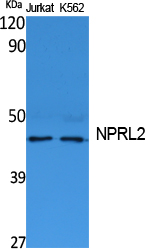NPRL2 Polyclonal Antibody
- Catalog No.:YT5086
- Applications:WB;ELISA
- Reactivity:Human;Mouse;Rat
- Target:
- NPRL2
- Fields:
- >>mTOR signaling pathway
- Gene Name:
- NPRL2
- Protein Name:
- Nitrogen permease regulator 2-like protein
- Human Gene Id:
- 10641
- Human Swiss Prot No:
- Q8WTW4
- Mouse Gene Id:
- 56032
- Mouse Swiss Prot No:
- Q9WUE4
- Immunogen:
- Synthesized peptide derived from the C-terminal region of human NPRL2.
- Specificity:
- NPRL2 Polyclonal Antibody detects endogenous levels of NPRL2 protein.
- Formulation:
- Liquid in PBS containing 50% glycerol, 0.5% BSA and 0.02% sodium azide.
- Source:
- Polyclonal, Rabbit,IgG
- Dilution:
- WB 1:500 - 1:2000. ELISA: 1:20000. Not yet tested in other applications.
- Purification:
- The antibody was affinity-purified from rabbit antiserum by affinity-chromatography using epitope-specific immunogen.
- Concentration:
- 1 mg/ml
- Storage Stability:
- -15°C to -25°C/1 year(Do not lower than -25°C)
- Other Name:
- NPRL2;TUSC4;Nitrogen permease regulator 2-like protein;NPR2-like protein;Gene 21 protein;G21 protein;Tumor suppressor candidate 4
- Observed Band(KD):
- 43kD
- Background:
- function:Suppresses Src-dependent tyrosine phosphorylation and activation of PDPK1 and its downstream signaling. Down-regulates PDPK1 kinase activity by interfering with tyrosine phosphorylation at the Tyr-9 Tyr-373 and Tyr-376 residues. May act as a tumor suppressor. Suppresses cell growth and enhanced sensitivity to various anticancer drugs.,similarity:Belongs to the NPR2 family.,subunit:Interacts with PDPK1.,tissue specificity:Most abundant in skeletal muscle, followed by brain, liver and pancreas, with lower amounts in lung, kidney, placenta and heart. Expressed in most lung cancer cell lines tested.,
- Function:
- function:Suppresses Src-dependent tyrosine phosphorylation and activation of PDPK1 and its downstream signaling. Down-regulates PDPK1 kinase activity by interfering with tyrosine phosphorylation at the Tyr-9 Tyr-373 and Tyr-376 residues. May act as a tumor suppressor. Suppresses cell growth and enhanced sensitivity to various anticancer drugs.,similarity:Belongs to the NPR2 family.,subunit:Interacts with PDPK1.,tissue specificity:Most abundant in skeletal muscle, followed by brain, liver and pancreas, with lower amounts in lung, kidney, placenta and heart. Expressed in most lung cancer cell lines tested.,
- Subcellular Location:
- Lysosome membrane . Localization to lysosomes is amino acid-independent. .
- Expression:
- Most abundant in skeletal muscle, followed by brain, liver and pancreas, with lower amounts in lung, kidney, placenta and heart. Expressed in the frontal lobe cortex as well as in the temporal, parietal, and occipital lobes (PubMed:27173016, PubMed:26505888). Expressed in most lung cancer cell lines tested.
- June 19-2018
- WESTERN IMMUNOBLOTTING PROTOCOL
- June 19-2018
- IMMUNOHISTOCHEMISTRY-PARAFFIN PROTOCOL
- June 19-2018
- IMMUNOFLUORESCENCE PROTOCOL
- September 08-2020
- FLOW-CYTOMEYRT-PROTOCOL
- May 20-2022
- Cell-Based ELISA│解您多样本WB检测之困扰
- July 13-2018
- CELL-BASED-ELISA-PROTOCOL-FOR-ACETYL-PROTEIN
- July 13-2018
- CELL-BASED-ELISA-PROTOCOL-FOR-PHOSPHO-PROTEIN
- July 13-2018
- Antibody-FAQs
- Products Images

- Western Blot analysis of extracts from Jurkat, K562 cells, using NPRL2 Polyclonal Antibody. Secondary antibody(catalog#:RS0002) was diluted at 1:20000



